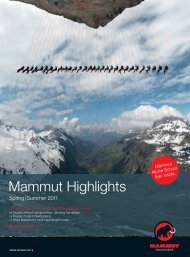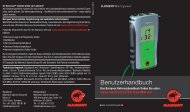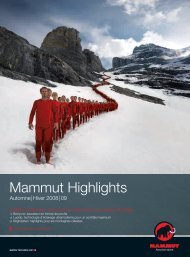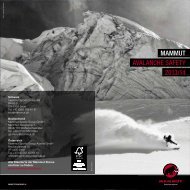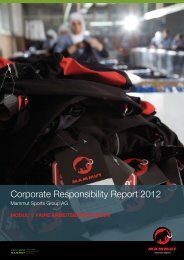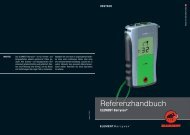Sleep Well - Mammut
Sleep Well - Mammut
Sleep Well - Mammut
You also want an ePaper? Increase the reach of your titles
YUMPU automatically turns print PDFs into web optimized ePapers that Google loves.
'Know-How'<br />
<strong>Sleep</strong> <strong>Well</strong><br />
Part 2 | Down 'Know-How'<br />
All to know about Downs<br />
© <strong>Mammut</strong> Sports Group AG, Switzerland, July 2005
'Know-How'<br />
2 8<br />
iNDEX:<br />
1. Down in general 3<br />
2. Quality<br />
2.1. In General 3<br />
2.2 Mixing Ratio 4<br />
2.3. Species: Duck or Goose 4<br />
2.4. White or grey (also called brown) down 5<br />
2.5. Dead and Live pluck 5<br />
2.6. Facts about Quality 6<br />
3. Ajungilak Quality Assurance 6<br />
4. Loft Power cuin 7<br />
Daune in general<br />
Quality<br />
Quality Assurance<br />
Loft power cuin<br />
© <strong>Mammut</strong> Sports Group AG, Switzerland, May 2006<br />
Authors<br />
Bernhard Ackermann, Product Manager Ajungilak, <strong>Mammut</strong> Sports Group AG<br />
Mick Farnworth, Senior Product Manager, <strong>Mammut</strong> Sports Group AG<br />
Robert Moss, Designer Developer, Packs/<strong>Sleep</strong>ing Bags<strong>Mammut</strong> Sports Group AG<br />
<strong>Mammut</strong> Sports Group AG<br />
Industriestrasse Birren, CH-5703 Seon<br />
info@mammut.ch
'Know-How'<br />
3 8<br />
1. Down in general<br />
Down grows in the feathers of ducks and geese and serves as insulation.<br />
“ Still“ air can be found trapped mostly around the chest and stomach area, which<br />
protects the animals from the cold in winter and from the heat in summer. Water<br />
birds are the only animals to have this special insulation process. Still air means<br />
that the air, as a result of the tiny down structures, cannot circulate. Thus no<br />
temperature adjustment takes place between the body and the environment, the<br />
body is insulated.<br />
Daune allgemein<br />
Qualität<br />
The trapping of the air succeeds because down is made up of incredibly small formations,<br />
just like a snowflake with a lot of tiny branches. A single down has about<br />
150 branchlets, each covered with fine hair and weighing just 1 to 4 milligrams.<br />
For our winter sleeping bags we need more than 1 million down feathers! A down<br />
feather, as opposed to normal feathers, does not have a keel, but just a tiny core,<br />
from which the branchlets protrude in a radial shape.<br />
Just like human hair, down is made of Keratin,<br />
a material which, even without trapping air, has<br />
very good insulation properties. Furthermore,<br />
Keratin conducts warmth very badly, which is<br />
the main reason, that down sleeping bags outperform<br />
synthetic sleeping bags when it comes<br />
to weight and warmth performance.<br />
Microscopic Picture of down<br />
2. Quality<br />
2.1. In general<br />
The quality is dependent on many factors. The following things are the main influences<br />
on the quality:<br />
© <strong>Mammut</strong> Sports Group AG, Switzerland, May 2006<br />
o Origin (climate), the best raw materials come from colder areas like: Siberia, East<br />
Europe, Canada or the Pyrenees.<br />
o Holding (Indoors or outdoors)<br />
o Age of the animal, the basic rule: the older an animal, the better the raw materials:<br />
o older animals have larger down and larger down automatically<br />
means more filling power.<br />
o older downs have a longer lifespan, since the down branches<br />
grow stronger over the years with knots (the down does not fall<br />
apart)<br />
o Plucking time (molting), in springtime the down is at its stron<br />
gest, and it is much cleaner, because at this time of year it is<br />
naturally detaches itself from the skin (dog skin)<br />
o Nutrition, the more balanced the nutrition, the better the quality of the down<br />
o Preparation (plucking, washing, sorting, drying); Transport, storage, filling
'Know-How'<br />
4 8<br />
2.2 Mixing Ratio<br />
The second important size to determine the down quality is the mixing ratio of<br />
the down and feathers. The specifications like, e.g. “ 90/10“ mean: 100 grams of<br />
this filling contains at least 90 grams of down. The higher the proportion of down<br />
in a filling, the higher the insulation with the same filling weight, since down traps<br />
more air than feathers. A 100 per cent down proportion is technically not possible,<br />
because it means the down has been selected by hand. A 95/5 value is top.<br />
When plucking the animal, you always get a mixture of down and feathers, which<br />
after washing is separated over a blower. Since down is lighter than feathers, they<br />
climb higher and further – the separation is based on this principle.<br />
Qualität<br />
There are of course feathers which have such good aerodynamics, that in spite of<br />
their higher weight, they fly with the down and climb just as high. These so called<br />
“ Floaters“ prevent the production of pure (100%) down fillings using a machine.<br />
Producers often like to attribute a supporting function to the feathers, which really<br />
is not necessary. Good downs do not need any feathers for stabilization, since<br />
good down is extremely puffy. A larger proportion of feathers makes the filling<br />
sensitive to pressure and moisture.<br />
Eiderdown has the reputation of being the best down. It has great properties, but<br />
so is the price, due to the time-consuming collection procedure : the down left<br />
in an empty nest is collected by hand, piece by piece. (In our winter sleeping<br />
bags we have about 1 million down feathers!!). This unbelievably expensive filling<br />
material (more than double the price of white goose down) is thus not suitable for<br />
commercial products.<br />
2.3. Species: Duck or Goose<br />
© <strong>Mammut</strong> Sports Group AG, Switzerland, May 2006<br />
Generally sleeping bags are made from down from either ducks or geese.<br />
The quality of duck down available varies from bad quality to good quality (200<br />
cuin bis 600 cuin). The goose qualities, in comparison, range from middle to best<br />
quality (450 cuin to 800 cuin). The down from geese and ducks in the middle quality<br />
area differentiate themselves not through their quality or insulation, but just<br />
through their price! As a consequence of the bad qualities available, duck down<br />
has an image problem. There are no tests which show any performance disadvantages<br />
between duck and goose down, of the same quality (cuin, mixing ratio)<br />
A further reason why the duck down is 30% cheaper than the same quality goose<br />
down, is that the food industry demands much more duck than goose. Due to<br />
this there is much more duck down on the world market than goose down, which<br />
sinks the price.<br />
Fact<br />
Whether duck or goose down, for quality in the area of up to 550 cuin there are<br />
no performance influences. Thus Ajungilak uses top duck down for the Taiga Line.<br />
For high-end down qualities (over 600cuin) goose down has to be selected. For the<br />
Altitude and Ascent Line Ajungilak exclusively uses goose down.
'Know-How'<br />
5 8<br />
GOOSEDOWN<br />
DUCKDOWN<br />
SAME QUALITY<br />
300 cuin / BAD QUALITY 550 cuin / GOOD QUALITY 750 cuin / BEST QUALITY<br />
Qualität<br />
2.4. White or grey (also called brown) down<br />
White down has exactly the same pressure properties and insulation performance<br />
as grey down. It is also just as clean, because the color difference comes from the<br />
downs pigment. The only difference, besides the color, is the price.<br />
The price for white down is higher than that of grey, because the demand for white<br />
down is a lot higher. The reason for this is human aesthetics; through thin and light<br />
fabric you can see the structure of the grey down strikingly well, whereas the white<br />
down does not gleam through.<br />
Fact<br />
For our high performance sleeping bags, Ajungilak exclusively uses pure white<br />
down, because it clearly has a better look. For the Taiga line though, where thicker<br />
fabric is used and the down can‘t shine through, we use the cheaper grey alternative.<br />
2.5. Dead and Live pluck<br />
The best down is found on the breast and stomachs of water birds. The down<br />
grows out of the skin of the animal (just like hair) and is supplied with blood from<br />
the body. In the molting season (spring) the body prepares for the rejecting of the<br />
down (because in summer less insulation is necessary than in winter – thus it is a<br />
natural process).<br />
© <strong>Mammut</strong> Sports Group AG, Switzerland, May 2006<br />
There are three methods to extract down:<br />
1. Mechanic plucking (normal dead pluck): the dead animals feathers are<br />
removed by a machine. With this method, all down and feathers are removed at<br />
the same time (all qualities). Due to this mechanical process, the down is slightly<br />
damaged as it is removed (breakages). Down that comes from mechanical plucking<br />
is good quality.<br />
2. Hand plucking: With this method, down is removed by hand from the live<br />
animal. If this is done during the molting season, then the process is part of the<br />
natural cycle. With the right handling the animal does not feel any pain. On many
'Know-How'<br />
6 8<br />
farms, down is plucked all year round – even if the animals body is not naturally<br />
rejecting it. Thus live plucking is justifiably unpopular with consumers. This “unclean“<br />
is however, very good quality, but out of respect it is not used by Ajungilak.<br />
3. Hand plucking a dead animal: With this time-consuming method the<br />
down is extracted from the oldest animals (therefore dead pluck) by hand. Thus<br />
this is “very clean “down and quality-wise, the best available down quality, because<br />
it comes from old animals and does not get damaged as it is removed (as is the<br />
case with machine plucking). Because it is done by hand, only the best down from<br />
the stomach and breast is selected (no watering-down of quality).<br />
For reasons of respect and our extremely high standards, Ajungilak uses down<br />
exclusively from Eastern European hand-plucked dead animals for the high quality<br />
lines and Mechanic plucked down for the entry level line Taiga.<br />
2.6. Facts about Quality<br />
The best raw materials come from mature, well-kept animals from cold areas like<br />
Eastern Europe. The best holds and nutrition is guaranteed to the mother animals,<br />
because they are the capital of every breeding farm. The mother animals are<br />
not used for meat until they are 4 years old. This is already very old for a breeding<br />
animal, because geese and ducks are usually plucked for the first time at the age<br />
of 16 weeks and after 50 weeks are usually sold as meat products. Down products<br />
of this origin are very inexpensive, but unsuitable for high quality sleeping<br />
bags (durability, loft power).<br />
Qualitätssicherung Qualität<br />
But these things alone not enough to get good quality, because not until a careful<br />
preparation of the raw materials (washing and sorting) takes place, does a good<br />
filling result. The preparation is as time-consuming as the production of a good<br />
wine, because every raw material is different. Too little washing detergent and<br />
the filling stinks, too much and it becomes brittle. The down used by Ajungilak is<br />
carefully cleaned at one of the world’s best down processing plants in Germany<br />
using the most modern equipment and the highest standards of technology, and is<br />
then dried at about 100°C and sterilized. This process is necessary for the down to<br />
give it maximum performance, and make it hygienic and neutral-smelling.<br />
© <strong>Mammut</strong> Sports Group AG, Switzerland, May 2006<br />
For the top lines Ascent and Altitude, Ajungilak processes down exclusively from<br />
East European mother animals. The down, with its certificate of origin and guarantee<br />
of quality, is washed by our strategic alliance partner Peter Kohl AG in Germany<br />
with the most modern equipment, it is then sorted and bagged.<br />
3. Ajungilak Quality Assurance<br />
The qualities of the down vary from supplier to supplier because it is a natural product<br />
(like grapes for wine). Added to this is the fact that quality tests are expensive<br />
and it is hard to know what is really is in your sleeping bag.<br />
Good contacts and mutual trust in a knowledgeable leader in the down branch is<br />
thus elementary to be able to deliver constant top quality.
'Know-How'<br />
7 8<br />
Therefore Ajungilak cooperates in a strategic alliance closely with the german,<br />
traditional Peter Kohl AG from Frankfurt.<br />
Our supply partner is a German company with 100 years of experience of collecting,<br />
sorting and washing down. Peter Kohl AG has very close long term relationship<br />
to down farms, to ensure that they receive the best raw material from the<br />
coldest climatic areas<br />
Trust is good, checks are better. With this slogan in mind, ever delivery is supplied<br />
with the down test certificates of IDFL (International Down and Feather Laboratories,<br />
the largest and most serious down testing organization in the world based in Salt<br />
Lake and Zurich). For definite confirmation of quality, we at Ajungilak also test in<br />
our own direction with IDFL and the German quality institute in Hohenstein.<br />
4. Loft Power cuin<br />
The Loft is the puff/filling power of the down (expansion power after it has been<br />
compressed). Thus a loft power of 700 cuin, that one ounce (28 grams) of this<br />
down stores, has a volume of 700 cubic inches (i.e. 11.5 liters air). To identify<br />
the loft power, the down is loaded down in a glass or Plexiglas cylinder (piercing<br />
cylinder) with a weight weighing 100 grams, and then the volume of the filling is<br />
measured; the more volume, the better the down quality. Good down has a value<br />
of 500cuin, very good reaches 650cuin. Top values lie between 700 and 800cuin.<br />
According to the International Standard, no values are measured higher than<br />
800 cuin. All down with higher cuin values (especially American brands), use the<br />
American method to measure the loft power. This method allows pretreatment of<br />
the down, through which these higher loft values are reached. This pretreatment<br />
(vaporization, chemical conditioning) does not correspond to the needs of the<br />
sleeping bag user.<br />
You would never get into a pretreated sleeping bag. The American measuring<br />
method is an interesting marketing trick, which does not give the consumers any<br />
more value. 950 cuin by American standards is about 800 cuin by international<br />
standards.<br />
To be convincing, Ajungilak regularly communicates with the quality assurers IDFL<br />
and the laboratory Hohenstein in Germany, to get down test results in accordance<br />
with the international standard. (EN 12934).<br />
Füllkraft cuin<br />
© <strong>Mammut</strong> Sports Group AG, Switzerland, May 2006<br />
Cuin is the fillingpower of down. This means, the volume that one ounce (28<br />
grams) of that down take in the lorch cylinder<br />
Volume of 28 Gramm Daune:<br />
500 cuin = 8 Liter<br />
600 cuin = 10 Liter<br />
780 cuin = 13 Liter
© <strong>Mammut</strong> Sports Group AG, Switzerland, July 2005<br />
'Know-How'








